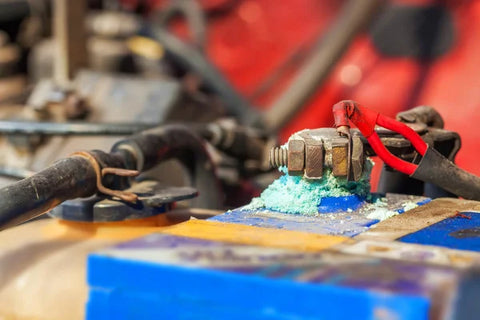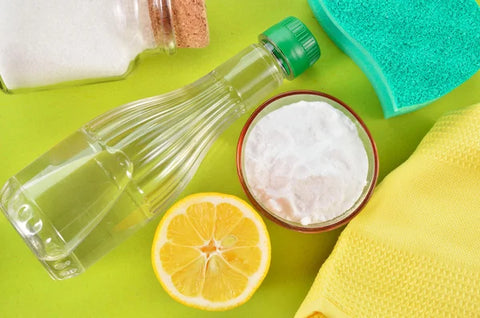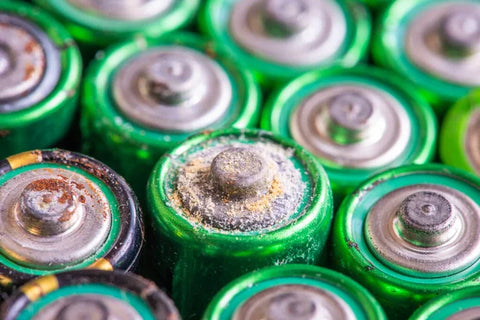
How to Clean Battery Corrosion Like a Pro | Fomin
Share
Have you ever opened your car or any other gadget battery to find a fuzzy, greenish substance staring back at you? Whether it's your car battery or home gadgets, the yucky stuff on batteries can harm your devices. The question is, how do you tackle battery corrosion like a pro without causing damage to your devices or risking your safety?
So, in this guide, we’ll discuss some valuable tips on how to clean battery corrosion like a seasoned pro. Don't miss out on these valuable insights – your gadgets will thank you!
Why Does Car Battery Corrosion Happen?
Before discussing how to clean corrosion off car battery, let’s discuss how it happens.

Corrosion around your car battery posts occurs due to sulfuric acid and hydrogen gas vapor escaping from the battery. This vapor sometimes vents out through the top vent blocks, but it can also leak between the posts and where they seal to the plastic casing.
When this vapor mixes with other gases under the hood, the engine's heat, differences in lead composition, copper from battery wires, and various factors contribute to corrosion.
How To Clean Battery Corrosion?
Before diving into how to clean battery corrosion on car, ensure you've got everything you need. Double-check that you have the right safety gear, and consider grabbing a respirator for added protection.
Using Battery Cleaner

- Disconnect the cables (start with black, then red).
- Spray the cleaning solution over the battery until the affected area is completely covered.
- With sturdy rubber gloves, use a wire brush to scrub away the corrosion. Ensure you cover the battery case thoroughly.
- Reattach the cables in the reverse order and close the hood.
Using Baking Soda and Water
- Disconnect the cables (begin with black, then red).
- Sprinkle baking soda over the corroded area to neutralize the battery acid.
- Add a small amount of water to activate the baking soda, triggering a chemical reaction that eliminates the corrosion.
- Wipe and dry the area with a dry cloth, and use a scrub sponge to clean up any remaining residue.
- Reattach the cables in the reverse order and close the hood.
How To Clean Off Battery Corrosion From Household Gadgets?
Step# 1: Essentials for Battery Corrosion Cleanup
To clean corrosion from your electronics, gather these supplies:
- Shield your skin from the chemicals in batteries
- Protect your eyes from potential splatters
- Finally, you can use them without risking your eardrums
- Neutralize battery discharge, especially from household batteries
- Safely clean electronics without leaving moisture or residue
- Tools to tidy up any fibers from cotton swabs.
Step# 2. Protect Yourself from Chemical Burns
Battery discharge is not only messy but also caustic. Safeguard yourself:
- Wear protective gloves made of cloth or synthetic rubber
- Use safety goggles to shield your eyes from dried battery discharge flecks
- Consider wearing long-sleeved clothing for added protection
Step# 3: Neutralize Discharge with Acid

Most household batteries have base chemicals. Neutralize them with acids:
- Power off the device
- Apply a few drops of lemon juice/vinegar with a cotton swab to the affected area
- Watch the whitish discharge fizz and disintegrate
Step# 4: Apply Isopropyl Alcohol
- For a clean finish, use isopropyl alcohol
- It removes residue without adding moisture
- Make sure you use a pure form (90% to 99%)
Step# 5: Wipe (or Blow) it Dry
- Wipe the area with a microfiber cloth
- Polish smaller sections with a pencil eraser
- Use compressed gas to eliminate any remaining fibers from cotton swabs
How To Clean Battery Terminal Corrosion?
- Wear safety glasses, gloves, and a long-sleeve shirt to shield against debris.
- Take the battery out of the device's compartment.
- Use white vinegar or lemon juice with a cotton swab to neutralize acid.
- Apply a few drops and wait until the corrosion fizzes or disintegrates.
- For larger deposits, use an old toothbrush with vinegar or lemon juice.
- After neutralizing, eliminate oxidation from the battery compartment.
Professional Cleaning Products for Battery Corrosion

- Battery Corrosion Cleaner: Shake it and spray it on corrosion. Wait a few minutes, then brush away the corrosion.
- Corrosion Preventative: Spray after cleaning terminals to prevent new corrosion quickly.
- Battery Post Brush: It is thimble-sized with metal bristles for battery post-cleaning. It is handy but optional if you clean your car battery infrequently.
- WD-40: It only works into the battery corners to neutralize corrosion. If not cleaned out, it can become grime tomorrow.
Conclusion
Learning how to clean battery corrosion is crucial for DIY enthusiasts and gadget fans. We hope this guide has shared useful tips on why battery corrosion happens and how to clean it like a pro.
Whether you use special cleaning solutions, household cleaners like baking soda, or professional products, the main thing is to stay safe and get rid of the corrosion well. With this info, you can make your batteries and devices last longer!
Building a Plastic-Free Future: Fomin's Commitment to Driving Sustainability
In an era where plastic pollution has become an alarming global issue, it is crucial to seek innovative solutions to reduce its devastating impact on our oceans and ecosystems. Annually, an astounding 8 million metric tons of plastic waste goes into our oceans, endangering marine life and the sensitive equilibrium of biodiversity on Earth. Fomin, a pioneer in sustainable initiatives, has driven the movement toward a plastic-free planet.
By purchasing Fomin's eco-friendly cleaning products, you actively participate in the battle against plastic pollution. Join our loyalty program to participate in building a sustainable future - one where plastic is not a threat but a relic of the past.
FAQ
How To Clean Car Battery Corrosion?
To clean your car batteries, apply the solution of 1 tbsp baking soda and ½ cup water with a toothbrush or battery terminal and gently scrub the corroded areas on the battery terminals and cable ends. After scrubbing, use a spray bottle filled with water to rinse off the solution and clean it with a dry cloth.


